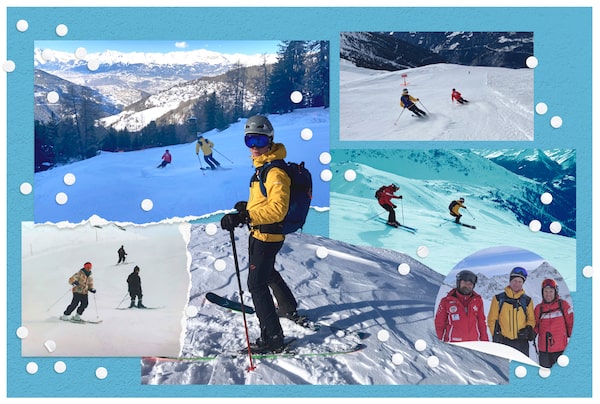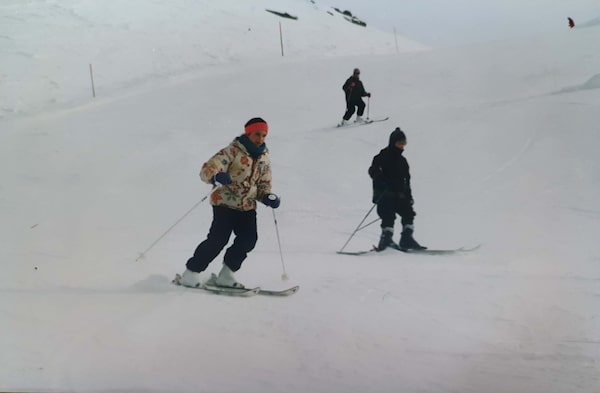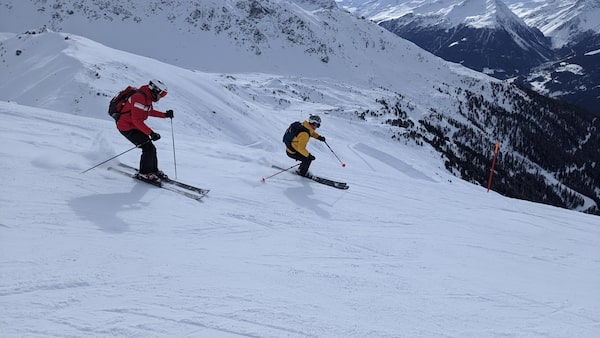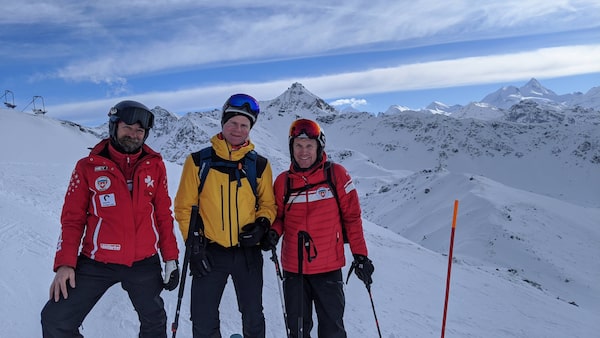
Clockwise from top left: Simon Akam follows Swiss ski instructor Bartek Pelczarski down a run with the village of Chandolin in the background; Mr. Akam follows instructor Pelczarski above Chandolin; Swiss ski instructor Christophe Hagin follows behind Mr. Akam; Mr. Akam flanked by instructors Pelczarski and Hagin; Mr. Akam pauses above Chandolin; Mr. Akam skiing with the daughter of his Swiss exchange family over Christmas 1996-97.Illustration by Photo illustration by The Globe and Mail
More from this series • A journalist returns to the mountains after a near-death ski experience
A photograph from my time as a child in the Swiss village of Chandolin distills, in many ways, the objectives of the entire project I’m chronicling here, in my series for The Globe and Mail. In the image, slightly blurred from a film camera quarter of a century ago, the daughter of my Swiss host family and I are skiing down a run above the treeline. I was 11, she was about the same age. Our equipment places the scene in the mid-1990s – rear-entry ski boots, skis with arrow-straight edges and no indication of the later ubiquitous side cut.
Yet, despite the aged materiel, the distinction in the manner of our skiing, or put more generally, our posture, is profound. She is neatly bent at the knee, forward against the front of the boots, hands raised as if in a hoop around the waist. This is the classic dynamic skier’s stance, a charged, ready-for-anything position analogous to a boxer or a goalkeeper about to receive a penalty. I, by contrast, am jammed against the back of my ski boots, rearing away from the – rather modest – slope. My eyeline is down, my hands hang limply. Such is the position du ski britannique.

Simon Akam (centre right) skiing with the daughter of his Swiss exchange family in the village of Chandolin over Christmas in 1996-97. This was only Akam's second time on skis.Handout
In some ways, the old photograph provides an unfair comparison. That stint in Chandolin in 1996-97 was the second time I had ever set foot on skis. The family I was with lived in Geneva, down in the flatlands, but this was still their backyard. And, examining the shot, I thought perhaps the old film camera caught me at a particularly off moment, and elsewhere I was dynamic and “résolument face à la pente” – resolutely facing the slope, a phrase that, of late, has been drilled into me. (Unfortunately this appears also not to be the case – after I began writing this column, my old host family was able to dig up some Super 8 film from my childhood visit. It has no sound, beyond an artificial projectionist’s ticker added by the digitization process, but it bears silent witness to my childhood skiing. The position du ski britannique was consistent.)
This project is about correcting those faults. It is about acknowledging that I have been doing something wrong for a long time and going back to try and learn to do it right. And – at least I hope – while that applies to skiing, it has overlays with wider human experience.

Christophe Hagin, a Swiss ski instructor who runs the ski school in Chandolin, follows behind Simon Akam below the summit of the Ilhorn peak on Jan. 24.Christophe Hagin and Bartek Pelczarski/Handout
In my planning calls before Christmas with Christophe Hagin, who runs the ski school here in Chandolin, we discussed my objectives. I want to have my downhill skiing technique fully overhauled, in order to, I hope, take part next year in the Patrouille des Glaciers, a 57.5 km ski mountaineering race with over 4,000 m. of climb. Unsaid, I want to put behind me the experience of nearly getting killed on a mountain in Russia in 2017 and subsequently going to pieces mentally. Christophe seemed to appreciate the intent from the start. I was seeking, he suggested, une expérience primordial.
It was clear that, although I was aiming for the high mountains, in Christophe’s view this process would start on the piste, on groomed runs. This approach is not universally shared. I also talked, during the endless and often highly confusing process of working out what equipment to buy, to one British ski mountaineer. He suggested disparagingly that the Swiss would make me do “drills on piste” as though this were some curious Helvetian preoccupation, akin to numbered bank accounts or a complex bespoke relationship with the European Union. (In the interests of fairness, money laundering regulations have in recent years kneecapped the traditional anonymity of Swiss finance.)

Mr. Akam (centre) is flanked by Swiss ski instructors Bartek Pelczarski, left, and Mr. Hagin high in the mountains above above Chandolin. Akam is working with the instructors to overhaul his skiing technique as he trains for next year's Patrouille des Glaciers, a 57.5 km ski mountaineering race.Christophe Hagin and Bartek Pelczarski/Handout
In the last few weeks, however, I have been converted to this Swiss approach, which I imagine is probably shared by most Alpine countries. Christophe and I spent a week undertaking drills on piste before moving to the most gentle, immediately adjacent-to-the-piste backcountry. I am glad of that now. Of course, to work this way, one needs the luxury of time. I earmarked two months at the start of this project to have my technical skiing rebuilt – longer than some said I needed – but, again, I am glad of that decision. We had time in hand. We executed drill after drill – short radius turns, longer radius carving turns, skiing with the poles held horizontally, then the poles balanced on the wrists.
The experience was to me one of blossoming complexity, where before I thought there was simplicity. A turn on skis, how knotty can that be? Actually very knotty. Again, here there is a truth that runs beyond skiing. Dismantle a tennis forehand, take a yoga pose to pieces and there is always a great deal to learn in an apparently simple movement. Body work, done properly, is a barcode. It contains multitudes.
Mr. Akam pauses skis above Chandolin. Much of his early training was held on the piste, on groomed runs, before venturing into more untamed territory.Christophe Hagin and Bartek Pelczarski/Handout
Day after day we skied, and when we paused, Christophe would trace sine curves in the snow with his pole to indicate the shape of the turn and its component phases, and unload a blizzard of technical vocabulary. (I’d made it clear I only wanted to speak French.) Extension, contre-rotation, virage court, virage grand. Extension, counterrotation, short turn, long turn. It was often cold and at times the amount of information seemed impossible to assimilate. But over time, assimilate it did. Not only did my technique improve, but the other skiers became studies to observe. The faults of some – excess body rotation, too much movement with their pole plants – began to glare. The skill of others, notably the confident, dynamic technique of those who have had race training, became deeply aspirational.
I found the process, in particular in the first week as my body adjusted, extremely intense. We did three hours of tuition per day and afterwards I was spent, mentally and physically. Over time, exhaustion lessened. But the work was also one of the most satisfying physical things I have ever done. Maybe that is because it is not purely physical. There is something profound in the link between body and mind, in particular an unquiet mind, as mine has sometimes been. There is connective tissue between muscle and brain, a line between fear and anxiety. Maybe that was why this process felt so right.
And then, with our piste drills done, we ventured off the beaten track …
Simon Akam is a British journalist and author. His first book, The Changing of the Guard – The British Army since 9/11, published in 2021, was a Times Literary Supplement book of the year and won the Templer First Book Prize. Simon can be found at @simonakam on Twitter, @simon.akam on Instagram.
Keep up to date with the weekly Sightseer newsletter. Sign up today.